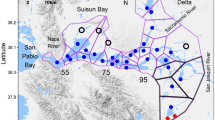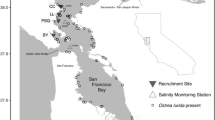Abstract
Setting of larvae of the oyster Crassostrea virginica was monitored in the James River, Virginia, USA from 1963 to 1980. Setting patterns were similar in two ways to those described prior to 1960 (before the onset of the oyster pathogen Haplosporidium nelsoni (MSX) in Chesapeake Bay): (1) setting intensity (average number of spat per shell) was greater at stations in the lower than upper estuary, and (2) on the average, 60 to 80% of the total annual set at each station occurred during a 6-week period from mid-August through September. However, annual setting intensity from 1963–1980 was lower than previously recorded, and annual sets occurred as a series of discrete pulses rather than continuously throughout the season. Pulses were each approximately 1 to 2 weeks in duration and separated by a period of diminished or no setting. Cross-correlation analysis of annual setting patterns among stations revealed three zones in the James River: the upper estuary and entire southwest side, the lower estuary, and a mid-estuary transition zone. Setting pulses tended to be synchronous at stations within each zone, but occurred 1 to 2 weeks later at stations in downriver than in upriver zones. The location of zones is related to known aspects of water circulation in the James River estuary. Moreover, pulse setting itself may be related to the absence of strong vertical salinity gradients accompanying the fortnightly stratification-destratification process.
Similar content being viewed by others
Literature cited
Andrews, J. D.: Seasonal patterns of oyster setting in the James River and Chesapeake Bay. Ecol. 32, 752–758 (1951)
Andrews, J. D.: Setting of oysters in Virginia. Proc. natl. Shellfish. Ass. 45, 38–46 (1954)
Andrews, J. D.: Oyster mortality studies in Virginia. VII. Review of epizootiology and origin of Minchinia nelsoni. Proc. Natl Shellfish. Ass. 58, 23–36 (1968)
Andrews, J. D.: Pelecypoda: Ostreidae. In: Reproduction of marine invertebrates, pp 293–241. Ed. by A. C. Geise and J. S. Pearse. New York: Academic Press 1979
Andrews, J. D.: The James River public seed oyster area in Virginia. Spec. Rept. appl. mar. Sci. Ocean Eng. Va. Inst. Mar. Sci. No. 261, 1–60 (1982)
Bender, M. E., R. J. Huggett and H. D. Slone: Heavy metals—an inventory of existing conditions. J. Wash. Acad. Sci. 62, 144–153 (1972)
Boicourt, W. C.: Estuarine larval retention mechanisms on two scales. In: Estuarine comparisons, pp. 445–457. Ed. by V. S. Kennedy. New York: Academic Press (1982)
Bowman, W. J. and R. L. Iverson: Estuarine and plume fronts. Ocean fronts in coastal processes. Proc. Mar. Sci. Res. Center May, 1977, pp 87–104 Ed. by M. Bowman and W. Esaias. New York: Springer-Verlag 1978
Carriker, M. R.: Ecological observations on the distribution of oyster larvae in N. J. estuaries. Ecol. Monog. 21, 19–38 (1951)
Dyer, K. R.: Localized mixing of low salinity patches in a partially mixed estuary (Southhampton Water, England). In: Estuarine comparisons, pp 21–36. Ed. by V. S. Kennedy, New York: Academic Press 1982
Fang, C. S. and B. Neilson: Oceanography, water quality and modeling studies for the outfall for a proposed Nansemond waste water treatment plant. Vol. V. Spec. Sci. Rept. appl. mar. Sci. Ocean Eng. Va. Inst. Mar. Sci. No. 86, 1–88 (1975)
Fishman, G. S.: Spectral methods in econometrics, 212 pp. Cambridge: Harvard University Press 1969
Haas, L. W.: The effect of spring-neap tidal cycle on the vertical salinity structure of the James, York, and Rappahannock Rivers, Virginia, U.S.A. Estuar. cstl mar. Sci. 5, 485–496 (1977)
Haskin, H. H.: The distribution of oyster larvae. In: Proceedings Symposium Experimental Marine Ecology Rhode Island. Occas. Publ. No. 2 Narragansett Mar. Lab., pp 76–80, Kingston University of Rhode Island 1964
Haven, D. S., W. J. Hargis, Jr. and P. C. Kendall: The oyster industry of Virginia: its status, problems and promise. A comprehensive study of the oyster industry in Virginia, 2nd edition. Spec. Pap. Mar. Sci., Va. Inst. Mar. Sci., No. 4, 1–1024 (1981)
Huggett, R. J. and M. E. Bender: Kepone in the James River. Envir. Sci. Technol. 14, 918–923 (1980)
Kennedy, V. S.: Comparison of recent and past patterns of oyster settlement and seasonal fouling in Broad Creek and Tred Avon River, Maryland. Proc. natl Shellfish. Ass. 70, 36–46 (1980)
Kunkle, P. E.: The vertical distribution of oyster larvae in Delaware Bay. Proc. natl Shellfish. Ass. 48, 90–91 (1958)
Korringa, P.: Relation between the moon and periodicity in the breeding of marine animals. Ecol. Monog. 17, 347–381 (1974)
Krantz, G. E. and D. W. Meritt: An analysis and trends in oyster spat set in the Maryland portion of Chesapeake Bay. Proc. natl Shellfish. Ass. 67, 53–59 (1977)
Loosanoff, V. L.: Observations on propagation of oysters in James and Corrotoman Rivers and the sea side of Virginia, 45 pp. Newport News: Virginia Commission Fisheries 1932
Loosanoff, V. L. and C. A. Nomejko: Spaning and setting of the American oyster, C. virginica in relation to lunar phases. Ecology 31, 113–134 (1951)
Loosanoff, V. L. and J. B. Engle: Spawning and setting of oysters in Long Island Sound in 1937, and discussion of method for predicting the intensity and time of oyster setting. Bull. Bur. Fish. 49, 217–255 (1940)
Manning, J. H. and J. H. Whaley: Distribution of oyster larvae and spat in relation to some environmental factors in a tidal estuary. Proc. Natl. Shellfish. Ass. 45, 56–65 (1954)
Nelson, T. C.: Observations of the behavior and distribution of oyster larvae. Proc. natl Shellfish. Ass. 45, 23–28 (1955)
Pritchard, D. W.: Salinity distribution and circulation in the Chesapeake Bay estuarine system. J. mar. Res. 11, 106–123 (1952)
Pritchard, D. W.: Distribution of oyster larvae in relation to hydrographic conditions. Proc. Gulf Carib. Fish. Inst. 5, 123–132 (1953)
Prytherch, H. F.: Investigation of the physical conditions controlling spawning of oysters and the occurrence, distribution, and setting of oyster larvae in Milford Harbor, Conn. Bull. Bur. Fish. 44, 429–503 (1928)
Ruzecki, E. P. and R. W. Moncure: Dye distribution results from point release in the James River model, pp 1–22. In: Utilization of physical and mathematical models in marine water resources research, planning and management. A report for the period Sept. 1967–Dec. 1968. Ed. by W. J. Hargis, Jr. Gloucester Point: Virginia Institute of Marine Science 1968
Seliger, H. H., J. A. Boggs, W. H. Biggley and K. R. H. Aspden: The transport of oyster larvae in an estuary. Mar. Biol. 71, 57–72 (1982)
Ulanowicz, R. E., W. E. Caplins and E. A. Dunnington: The forecasting of oyster harvest in central Chesapeake Bay, pp 101–106. In: Estuarine and marine science. New York: Academic Press 1980
Welch, C. S. and B. J. Neilson: Newport News circulation study. Spec. Sept. Appl. Mar. Sci. Ocean Eng., Va. Inst. Mar. Sci. No. 87, 1–105 (1975)
Wood, L. and W. J. Hargis, Jr.: Transport of bivalve larvae in a tidal estuary, pp 21–44. In: Fourth Eur. Mar. Biol. Symp. Ed. by D. J. Crisp. Cambridge: Cambridge University Press 1971
Author information
Authors and Affiliations
Additional information
Communicated by J. M. Lawrence, Tampa
Contribution No. 1213 from the Virginia Institute of Marine Science, School of Marine Science, The College of William and Mary
Rights and permissions
About this article
Cite this article
Haven, D.S., Fritz, L.W. Setting of the American oyster Crassostrea virginica in the James River, Virginia, USA: temporal and spatial distribution. Mar. Biol. 86, 271–282 (1985). https://doi.org/10.1007/BF00397514
Accepted:
Issue Date:
DOI: https://doi.org/10.1007/BF00397514




